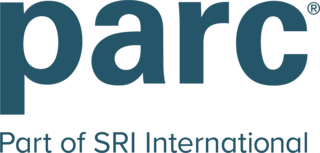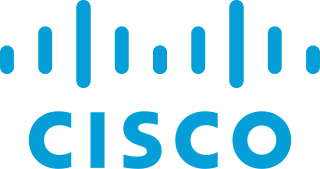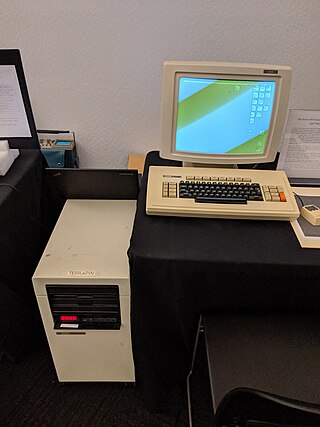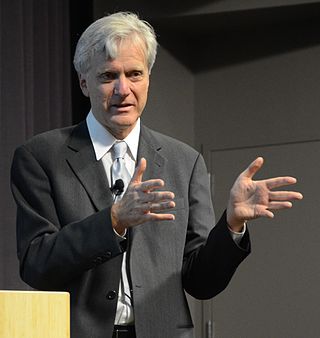Related Research Articles

A router is a computer and networking device that forwards data packets between computer networks, including internetworks such as the global Internet.

SRI Future Concepts Division is a research and development company in Palo Alto, California. It was founded in 1969 by Jacob E. "Jack" Goldman, chief scientist of Xerox Corporation, as a division of Xerox, tasked with creating computer technology-related products and hardware systems.
A network operating system (NOS) is a specialized operating system for a network device such as a router, switch or firewall.
Xerox Network Systems (XNS) is a computer networking protocol suite developed by Xerox within the Xerox Network Systems Architecture. It provided general purpose network communications, internetwork routing and packet delivery, and higher level functions such as a reliable stream, and remote procedure calls. XNS predated and influenced the development of the Open Systems Interconnection (OSI) networking model, and was very influential in local area networking designs during the 1980s.

Cisco Systems, Inc.,, is an American multinational digital communications technology conglomerate corporation headquartered in San Jose, California. Cisco develops, manufactures, and sells networking hardware, software, telecommunications equipment and other high-technology services and products. Cisco specializes in specific tech markets, such as the Internet of things (IoT), domain security, videoconferencing, and energy management with leading products including Webex, OpenDNS, Jabber, Duo Security, Silicon One, and Jasper.
Chaosnet is a local area network technology. It was first developed by Thomas Knight and Jack Holloway at MIT's AI Lab in 1975 and thereafter. It refers to two separate, but closely related, technologies. The more widespread was a set of computer communication packet-based protocols intended to connect the then-recently developed and very popular Lisp machines; the second was one of the earliest local area network (LAN) hardware implementations.

The Xerox Alto is a computer system developed at Xerox PARC in the 1970s. It is considered one of the first workstations or personal computers, and its development pioneered many aspects of modern computing. It features a graphical user interface (GUI), a mouse, Ethernet networking, and the ability to run multiple applications simultaneously. It is one of the first computers to use a WYSIWYG text editor and has a bit-mapped display. The Alto did not succeed commercially, but it had a significant influence on the development of future computer systems.

The Xerox Star workstation, officially named Xerox 8010 Information System, is the first commercial personal computer to incorporate technologies that have since become standard in personal computers, including a bitmapped display, a window-based graphical user interface, icons, folders, mouse (two-button), Ethernet networking, file servers, print servers, and email.

Andreas Maria Maximilian Freiherr von Mauchenheim genannt Bechtolsheim is a German electrical engineer, entrepreneur and investor. He co-founded Sun Microsystems in 1982 and was its chief hardware designer. As of March 2024, Forbes estimated his net worth at $16.3 billion.

Robert William Taylor, known as Bob Taylor, was an American Internet pioneer, who led teams that made major contributions to the personal computer, and other related technologies. He was director of ARPA's Information Processing Techniques Office from 1965 through 1969, founder and later manager of Xerox PARC's Computer Science Laboratory from 1970 through 1983, and founder and manager of Digital Equipment Corporation's Systems Research Center until 1996.
Leonard X. Bosack is a co-founder of Cisco Systems, an American-based multinational corporation that designs and sells consumer electronics, networking and communications technology, and services. His net worth is approximately $200 million. He was awarded the Computer Entrepreneur Award in 2009 for co-founding Cisco Systems and pioneering and advancing the commercialization of routing technology and the profound changes this technology enabled in the computer industry.
LattisNet was a family of computer networking hardware and software products built and sold by SynOptics Communications during the 1980s. Examples were the 1000, 2500 and 3000 series of LattisHub network hubs. LattisNet was the first implementation of 10 Megabits per second local area networking over unshielded twisted pair wiring in a star topology.
Sandy Lerner is an American businesswoman and philanthropist. She co-founded Cisco Systems, and used the money from its sale to pursue interests in animal welfare and women's writing. One of her main projects, Chawton House, is in England, but most of her work remains in the United States.
The PARC Universal Packet was one of the two earliest internetworking protocol suites; it was created by researchers at Xerox PARC in the mid-1970s. The entire suite provided routing and packet delivery, as well as higher level functions such as a reliable byte stream, along with numerous applications.

Sun-1 was the first generation of UNIX computer workstations and servers produced by Sun Microsystems, launched in May 1982. These were based on a CPU board designed by Andy Bechtolsheim while he was a graduate student at Stanford University and funded by DARPA. The Sun-1 systems ran SunOS 0.9, a port of UniSoft's UniPlus V7 port of Seventh Edition UNIX to the Motorola 68000 microprocessor, with no window system. Affixed to the case of early Sun-1 workstations and servers is a red bas relief emblem with the word SUN spelled using only symbols shaped like the letter U. This is the original Sun logo, rather than the more familiar purple diamond shape used later.

The 3M computer industrial goal was first proposed in the early 1980s by Raj Reddy and his colleagues at Carnegie Mellon University (CMU) as a minimum specification for academic and technical workstations. It requires at least one megabyte of memory, a one megapixel display with 1024×1024 1-bit pixels, and one million instructions per second (MIPS) of processing power. It was also often said that it should cost no more than one "megapenny" or $10,000.
MacIP refers to a standard for encapsulating Internet Protocol (IP) packets within the AppleTalk DDP protocol. This allows Macintosh computers with LocalTalk networking hardware to access the normally Ethernet-based connections for TCP/IP based network services. This was an important bridging technology during the era when Ethernet and TCP/IP were rapidly growing in popularity in the early 1990s.
Network Systems Corporation (NSC) was an early manufacturer of high-performance computer networking products. Founded in 1974, NSC produced hardware products that connected IBM and Control Data Corporation (CDC) mainframe computers to peripherals at remote locations. NSC also developed and commercialized the HYPERchannel networking system and protocol standards, adopted by Cray Research, Tektronix and others. In the late 1980s, NSC extended HYPERchannel to support the TCP/IP networking protocol and released a product allowing HYPERchannel devices to connect to the emerging Internet.
The SUN workstation was a modular computer system designed at Stanford University in the early 1980s. It became the seed technology for many commercial products, including the original workstations from Sun Microsystems.
References
- 1 2 "Network (SUNet — The Stanford University Network)". Stanford University Information Technology Services. July 16, 2010. Retrieved April 11, 2011.
- 1 2 3 Andreas Bechtolsheim; Forest Baskett; Vaughan Pratt (March 1982). The SUN Workstation Architecture (PDF). Stanford University Computer Systems Laboratory. Archived from the original (PDF) on July 1, 2011. Retrieved April 11, 2011. CSL Technical Report 229 (First author name is misspelled on cover)
- ↑ Rob Roberts, Wayne Sung. "SUNet: the Stanford University Network" (PDF). Presentation for Networkers ’99 on the Development of Stanford’s Backbone Network. Archived from the original (PDF) on 2016-03-04. Retrieved 2019-05-05.
- ↑ Vance, Ashlee (2007). Silicon Valley . Goulford, CT, USA: Globe Pequot Press. p. 117. ISBN 978-0-7627-4239-4.
- 1 2 Pete Carey (December 1, 2001). "A start-up's true tale". San Jose Mercury News . Retrieved February 27, 2011.